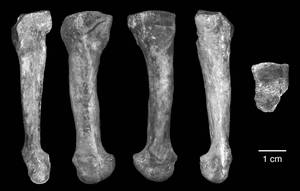Big news this week about the ability of Australopithecus afarensis to walk like a human. Researchers have found that this species of early hominin had rigid, arched feet. This means that afarensis would have spent a great deal of time walking only on two feet, which is just a step away from full bipedalism.
Researcher Carol Ward and colleagues from the University of Missouri have come to this conclusion over a fourth metatarsal (that's the Wayne Rooney foot bone for those that don't know). Found in Hadar, a well-dug fossil site in Ethiopia, this metatarsal is a perfect example of a bone which was lacking in the famous afarensis specimen known as Lucy.
 Publishing in the journal Science, the researchers think this bone points towards arched feet because its two ends are twisted in relation to each other. That means that one articular surface, where it meets the cuboid (that's one of the lumpy bones that makes up the body of the foot), sits at a different angle to the surface where it meets the phalanx (essentially in the first row of toe bones). This means that the foot was very unlikely to have been flat, and would have been quite well adapted to the 'push-off' motion that's required in walking or even running.
Publishing in the journal Science, the researchers think this bone points towards arched feet because its two ends are twisted in relation to each other. That means that one articular surface, where it meets the cuboid (that's one of the lumpy bones that makes up the body of the foot), sits at a different angle to the surface where it meets the phalanx (essentially in the first row of toe bones). This means that the foot was very unlikely to have been flat, and would have been quite well adapted to the 'push-off' motion that's required in walking or even running.
It fits in well with what we already know of afarensis' hips and spine, which do suggest quite upright walking: something which a chimpanzee can't do as efficiently. And walking on two feet between 3.7 and 2.9 million years ago should have made regular tool use possible. We don't know for certain that Lucy would have used stone tools but there was a study that came out last year in Nature, by Shannon McPherron and colleagues, which did seem to suggest that tool use was going on 3.4 million years ago. Previously it had been thought that tool use only started 2.5 million years ago, and was used by a much more human-like species of Homo than an australopithecine.










Comments
Add a comment